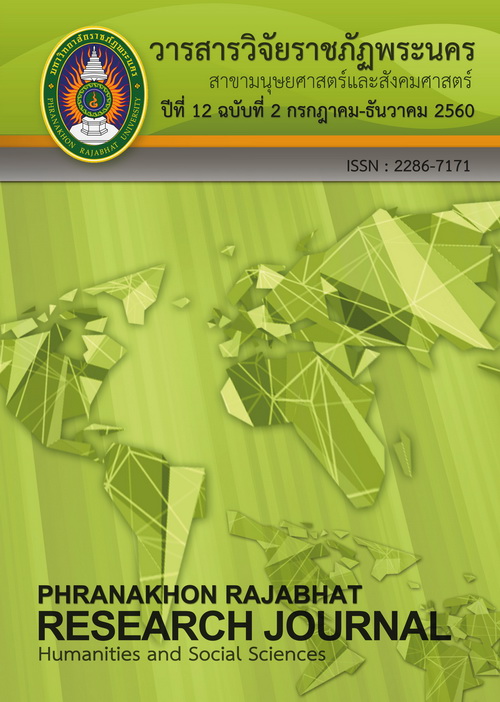PERCEPTION OF TRAVEL BUREAU, DESTINATIONS SATISFACTION AND INTENTIONS BEHAVIOUR OF FOREIGN TOURISTS IN BALI
Main Article Content
บทคัดย่อ
This study evaluates the tourism phenomenon in tourism destinations, namely the satisfaction of tourists use travel agents, satisfaction when visiting Bali and intention to revisit and recommendation. This study also aims to investigate the characteristics of tourists, including age, education, and future travel plans. This study uses 100 respondents. Respondents are those that come from Asia, Europe, and Australia as well as the American, who visited Bali in 2016. The method of data analysis using statistical analysis using SPSS
22. This research is expected to generate tourists satisfaction concept called TRAVSAT and DESSAT. This study found that more than 75 percent of foreign tourists still using Travel Bureau as a partner in tourist trip to Bali. There are 11 indicators that lead to satisfied tourists use Travel Bureau three of which are: 1) satisfaction with the convenience of transportation, 2) the satisfaction of service complaints, 3) the satisfaction of hotel services. While the satisfaction of tourists visiting Bali caused by 12 indicators, three of which are: 1) satisfaction airport services, 2) satisfaction of accommodation services, and 3) the satisfaction of the price
Article Details
บทความที่ได้รับการตีพิมพ์เป็นลิขสิทธิ์ของมหาวิทยาลัยราชภัฏพระนคร
ข้อความที่ปรากฏในบทความแต่ละเรื่องในวารสารวิจัยราชภัฏพระนครเล่มนี้เป็นความคิดเห็นส่วนตัวของผู้เขียนแต่ละท่านไม่เกี่ยวข้องกับมหาวิทยาลัยราชภัฏพระนคร และคณาจารย์ท่านอื่นๆในมหาวิทยาลัยฯ แต่อย่างใด ความรับผิดชอบองค์ประกอบทั้งหมดของบทความแต่ละเรื่องเป็นของผู้เขียนแต่ละท่าน หากมีความผิดพลาดใดๆ ผู้เขียนแต่ละท่านจะรับผิดชอบบทความของตนเองแต่ผู้เดียว
เอกสารอ้างอิง
Baker, D.A. & Crompton, J.L. (2000). Quality, satisfaction and behavioral.
Bali Provincial Tourism Office. (2015). Directory 2015. Intentions. Annal of Tourism Research, 27(3), 785-804.
Chen, Ching-Fu & Tsai, D. C. (2007). How destination image and evaluative factors affect behavioral intentions ?,
Tourism Management, (28), 5-1122
Chi, C. Geng-Qing & Qu, H. (2008). Examining the structural relationships of destination image, tourist satisfaction
and destination loyalty: an integrated approach. Tourism Management, 29(4), 624-636.
Coban, S. (2012). The effect of the image of destination on tourist satisfaction and loyalty: the case of Cappadocia.
European Journal of Social Sciences, 29(2), 222-232
Cooper, C., Fletcher, J., Gilbert, D. & Wanhill S. (1993). Tourism principles & practice. UK: PITMAN Publishing.
Crouch, G.I. (2007). Modelling destination c o m p e t i t i v e n e s s . A survey and analysis of the impact of
competitiveness attributes. Australia: CRC for Sustainable Tourism.
Darma Putra, I. N. & Pitana I Gede. (2010). Tourism pro people: breaking way alleviating poverty in Indonesia.
Jakarta: Ministry of Culture and Tourism.
Echtner, C. M. & Ritchie, J.R. Brent. (2003). The meaning and measurement of destination image. The Journal of
Tourism Studies, 14(1), 37-48.
Furutani, T. & Fujita A. (2005). A study on foreign tourists’ behavior and consumer satisfaction in Kamakura.
Journal of the Eastern Asia Society for Transportation Studies. 6, 2154-2169.
Gee, C.Y., Makens, J.C. & Choy, D. J.L. (1997). The travel industry. NY: Van Nostrand Reinhold.
Hair, J.F. JR., Anderson, R.E., Tatham, R.L. & Black, W.C. (1998). Multivariate data analysis, with readings. USA:
Prentice Hall International, INC.
Jengkins, O.H. (1999). Understanding and measuring tourist destination images.
Jennings, G. (2001). Tourism research. Australia: John Wiley & Sons. International Journal of Tourism
Research, 1, 1-15.
Kotler, P. (2002). Marketing management (millennium edition). Jakarta: Pearson Education and Prehanllindo.
Kozak, M. & Remmington, M. (2000). Tourist satisfaction with Mallorca, Spain as an off-season holiday destination.
Journal of Travel Research, 38, 260-269.
Li, W. (2011). Study of service recovery of travel agency based on customer satisfaction. International Conference
on Economic and Finance Research, IPEDR Vol. 4, IACSIT Press, Singapore
Malhotra, N.K. (2002). Basic marketing research: aplication to contemporary issues. International Edition. New
Jersey: Prentice Hall International.
Maroofi, F. & Dehghan, S. (2012). Investigating the relationships of reflect, tourist satisfaction and destination loyalty.
Word Applied Sciences Journal, 19(8), 1160-1173.
Martin, H.S., Collado, J. & Rodriguez, del Bosque Ignacio. (2009). A new approach to tourist service satisfaction with alternative comparation Standards. Journal of Travel and Tourism Research, Spring/Fall.
Meng, S., Liang, G. & Yang, S. (2011). The relationships of cruise image, perceived value, satisfaction and
post purchase behavioral intention on Taiwanese tourists. African Journal of Business Management, 5(1), 19-29.
Mill, R.C. & Morrison, A. (2009). The tourism system. 6th edition, USA: Kendall Hunt.
Mohamad, M., Ali, A.M. & Ab Ghani, N.I. (2011). A structural model of destination image, tourists’ satisfaction and
destination loyalty, International Journal of Business and Management Studies, 3(2), 167-177.
Moutinho, L.(2000). Strategic management in tourism. UK: CABI Publishing. Nam, J., Ekinci, Y. & Whyatt, G. (2011). Brand equity, brand loyalty and consumer satisfaction. Annals of Tourism Research, 58, 3, 1009-1030
Parasuraman, A., Zeithaml, V.A & Berry, L.L., (1985). A conceptual model of service quality and its implicatio for future
research. Journal of Marketing.
Reisinger, Y. & Turner, L. (2003). Crosscultural behaviour in tourism: concept and analysis. Oxford: Butterworth-
Heinemann.
Rodriguez, del Bosque Ignacio & Martin, H.S. (2008). Tourist satisfaction a cognitive–affective model. Annal of
Tourism Research, 35(2), 551-573.
Sudiarta, I.N. & Suardana, I.W. (2016). Tourism destination planning strategy: analysis and implementation
of marketing strategy city tour in Bali. Procedia Social Science,7, 664-670.
Sudiarta, I.N. (2015). Popularity of tourist attraction in Bali from the perspective of foreign tourists. E-Journal of
Tourism Udayana University, 2(2), 92-99.
Tjiptono, F. & Chandra, G. (2011). Service, quality & satisfaction. Yogyakarta: Andi.
Wall, G. (1996). Perspectives on tourism in selected Balinese villages, Annal of Tourism Research. 23(1), 123-137.
Wang, Kuo-Ching, Jao, Po-Chen, Chan, His- Chen & Chung, Chia-Hsun. (2010).Group package tour leaders’s intrinsic
risk. Annal of Tourism Research, 37(1), 55-179.
Widarjono, A. (2010). Applied Multivariate Statistics Analysis. Jogyakarta, UPP STIM YKPN, 235-144.
Zeithaml, M.J. & Bitner, V.A. (2003). Service Marketing. NY: McGraw-Hill Higher education.


